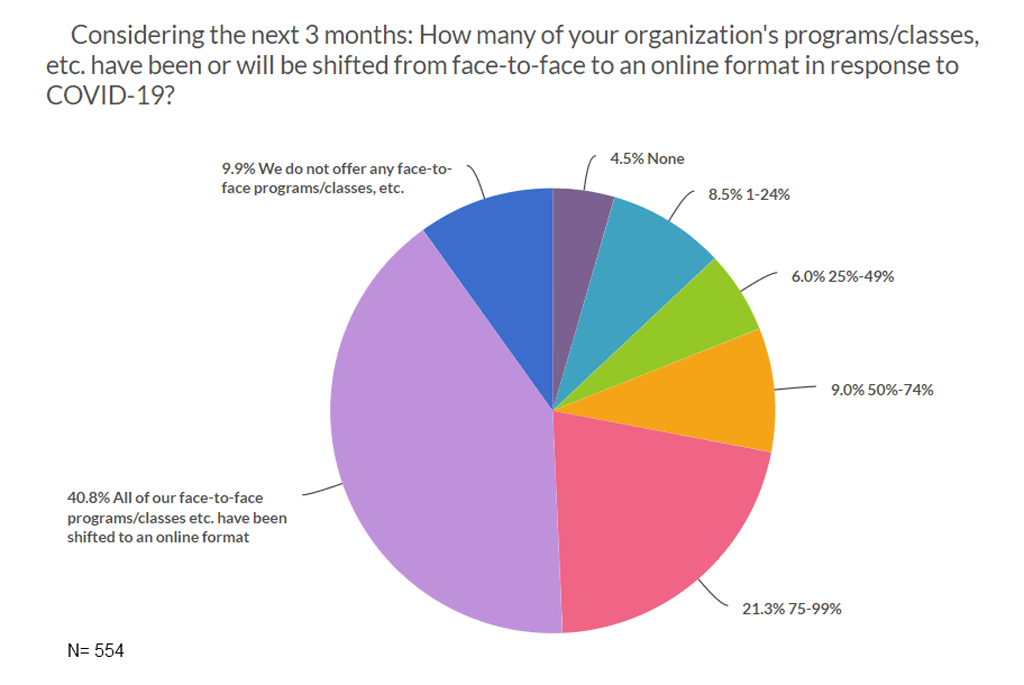Why Online Training is an Essential Business Tool During and After Closures from the COVID-19 Pandemic
For many businesses, most in-person events, processes, tools, and day-to-day work have transitioned to remote formats over the past few months. While some facilities are beginning to reopen, certain online initiatives have the potential to do better as a more permanent option. Workplace learning is one of them.
In a survey recently conducted by eLearning Guild, not surprisingly, they found that 86% of respondents had transitioned at least one or more in-person training events to an online format. Furthermore, 40% responded that all of their face-to-face training has been shifted to an online learning format.

Image: LearningSolutions
This isn’t to say that workplace learning has been immune from the financial effects of COVID-19. Some businesses have elected to cancel learning and development (L&D) initiatives scheduled for the near future. This is commonly the case when financial worries arise. But in this scenario, it’s clear that things are a little different. With so many businesses immediately shifting to online solutions, the impacts of COVID-19 have highlighted how online learning is not only a viable business tool, but a necessary one that’s here to stay.
Online training is the only surefire way to upskill while keeping employees safe and healthy
In the COVID-19 era, the key driver behind digital learning is now keeping people safe and reducing risk. Businesses can attempt to do safer, socially-distanced versions of face-to-face training. However, this will come with added investments in safety measures such as PPE and logistical hurdles, limiting the number of attendees, and/or staggering sessions. If travel is required for training sessions, that makes things even trickier.
Shifting to online training is not only the safest, but it’s the simplest way to ensure L&D initiatives can continue without major hassle or risk during the COVID-19 pandemic. Employees can train remotely and online from anywhere without endangering their health or the health of their coworkers.
The costs are far lower and the offerings more unique with online training
Online learning platforms have always had the advantage of cost and convenience over traditional, in-person training. When you compare the costs side-by-side, online training often costs 75% less for the same (or more) training material and number of attendees.
Even if travel costs are eliminated from the equation, online training still wins by a landslide.
This difference matters now more than ever as many industries are facing budget constraints, reduced demand, and decreased productivity. Online training provides a way for employees to stay productive. Plus, they can continue boosting skills in a way that’s affordable during uncertain times.
Not only that, but most online training platforms offer access to broader libraries of topics and courses. This allows managers to coordinate effective training plans for different teams, roles, and employee skill levels instead of relying on one set of training sessions for everyone.
Training has always been good for employee engagement. During COVID-19, it’s a way for remote workers to connect and stay motivated.
Several surveys have shown that employees continually support on-the-job training and feel more inclined to stay and be engaged in their role when they have access to continuous learning. LinkedIn Learning’s 2020 Workplace Learning Report found that 94% of participants saw the career benefits of making time to learn at work.
Ensuring that employees feel motivated in their roles is even more important during a global pandemic. Digital learning is an opportunity for remote employees to feel a sense of connection and community with their colleagues as they work through online training programs together.
Plus, since online training can be individualized, it can help employees feel that their work is purposeful and spur them to achieve their personal career goals. This could be anything from working towards an industry-recognized software certification or training in highly-specialized skills pertinent to their role on the team.
Online training is an essential business tool even after COVID-19
It’s not clear when or if the COVID-19 pandemic will really be “over,” but it’s already apparent that it will have long-lasting effects on how businesses operate. Many businesses, especially in manufacturing, that operated fully onsite may shift to allow some roles to be carried out remotely indefinitely. And many facilities will address safety concerns through staggering shifts or limiting capacity among others.
As we move towards a more remote and safety-conscious future, online learning will continue to build on the momentum it has gained as a result of the pandemic. Online training is here to stay and will solidify its position as an essential business tool. It will continue to be the best option to keep employees healthy and safe, and will also enable businesses to be more future-proof for any challenges that come their way.
























